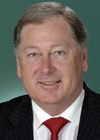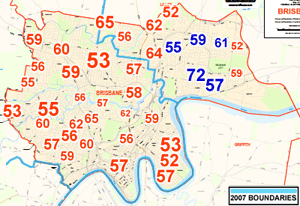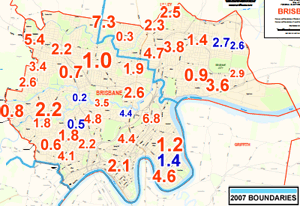Electoral Form Guide: Brisbane
Electorate: Brisbane
Margin: Labor 3.8%
Location: Central Brisbane, Queensland
In a nutshell: Brisbane was one of only two seat that Labor retained amid the 1996 landslide, a result that said as much about its lack of volatility as its security for Labor. The member since 1990 has been Arch Bevis, who has been done a bad turn by a redistribution that has pushed the seat eastwards into the highly affluent Clayfield area.
The candidates
|
|
ANDREW BARTLETT
|
|
|
Two-party vote map
|
Swing % map |
Electorate analysis: Brisbane has existed as an electorate since federation, and has been held by Labor since 1931 outside of the interruption of 1975 to 1980. There were close shaves in 1940, 1958, 1966 and 1996, with the margin cut below 1 per cent on each occasion, and unfavourable redistributions in 2004 and 2010 have prevented Labor consolidating since. The electorate currently covers the north shore of the Brisbane River from Milton through the CBD to Eagle Farm, extending north to Stafford at the western end and Hendra at the eastern. The redistribution has wrought highly significant changes, chopping territory in the west through Enoggera Military Camp out to Ferny Grove and Upper Kedron (sending 22,300 voters to Ryan) and at Stafford in the north (sending 5000 voters to Lilley) and adding a substantial new area in the east covering Hamilton and part of Eagle Farm on the river and Gordon Park, Clayfield and Hendra in the north (26,500 voters formerly in Lilley). Of particular significance is the area around Clayfield, the Liberal strength of which made the state seat of that name the only seat in Brisbane held by the party after the 2006 election. The result has been a substantial cut in the Labor margin, from 6.8 per cent to 3.8 per cent.
Arch Bevis has been the member since 1990 when he succeeded Manfred Cross, who had held the seat since 1961 outside of the interruption from 1975 to 1980. A member of the Labor Unity (“Old Guard”) sub-faction of the Queensland Right, Bevis served in the senior defence and industrial relations shadow portfolios in Labor’s first and second terms in oppositions. However, he was prevailed upon after the 2001 election to stand aside, making way for up-and-coming factional colleague Kevin Rudd, an outcome he blamed on the rival Labor Forum (Australian Workers Union) Right faction. He returned to the front bench after the 2004 election in the defence planning and personnel portfolios, moving to homeland security in June 2005, but was dropped when Labor came to power in 2007. Despite their factional relationship, it was not clear if Bevis supported Rudd in his successful December 2006 leadership challenge against Kim Beazley, with whom he had been close, and it has been said relations between the two have since been frosty. It was reported in July 2009 that Bevis’s preselection was under threat, with potential successors being “openly canvassed around the party”, but no challenger emerged.
The Liberal National Party has nominated Teresa Gambaro, who held the northern Brisbane seat of Petrie from 1996 until her defeat in 2007. Another former parliamentarian on the ballot paper is Greens candidate Andrew Bartlett, who was a Democrats Senator from 1997 to 2008 and leader of the party from 2002 to 2004.
 Brisbane was one of eight Queensland marginals targeted by a Newspoll survey in the second last week of the campaign, covering 200 respondents in each electorate. The poll showed a collective 3.4 per cent swing against Labor. Reports in the final week suggested the Coalition believed the seat to be beyond reach, but had not given up. As such, the 58.7-41.3 lead recorded for the LNP in the JWS Research-Telereach poll conducted in the final weekend of the campaign, which covering 400 respondents in the electorate with a margin of error of about 5 per cent, did not have the ring of truth.
Brisbane was one of eight Queensland marginals targeted by a Newspoll survey in the second last week of the campaign, covering 200 respondents in each electorate. The poll showed a collective 3.4 per cent swing against Labor. Reports in the final week suggested the Coalition believed the seat to be beyond reach, but had not given up. As such, the 58.7-41.3 lead recorded for the LNP in the JWS Research-Telereach poll conducted in the final weekend of the campaign, which covering 400 respondents in the electorate with a margin of error of about 5 per cent, did not have the ring of truth.
Analysis written by William Bowe. Read Bowe’s blog, The Poll Bludger.





